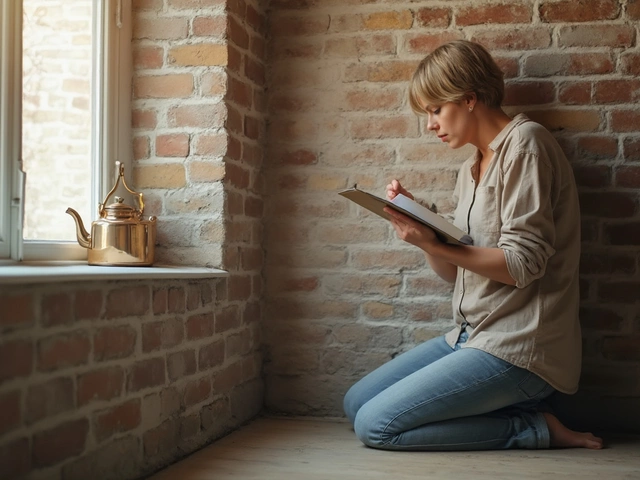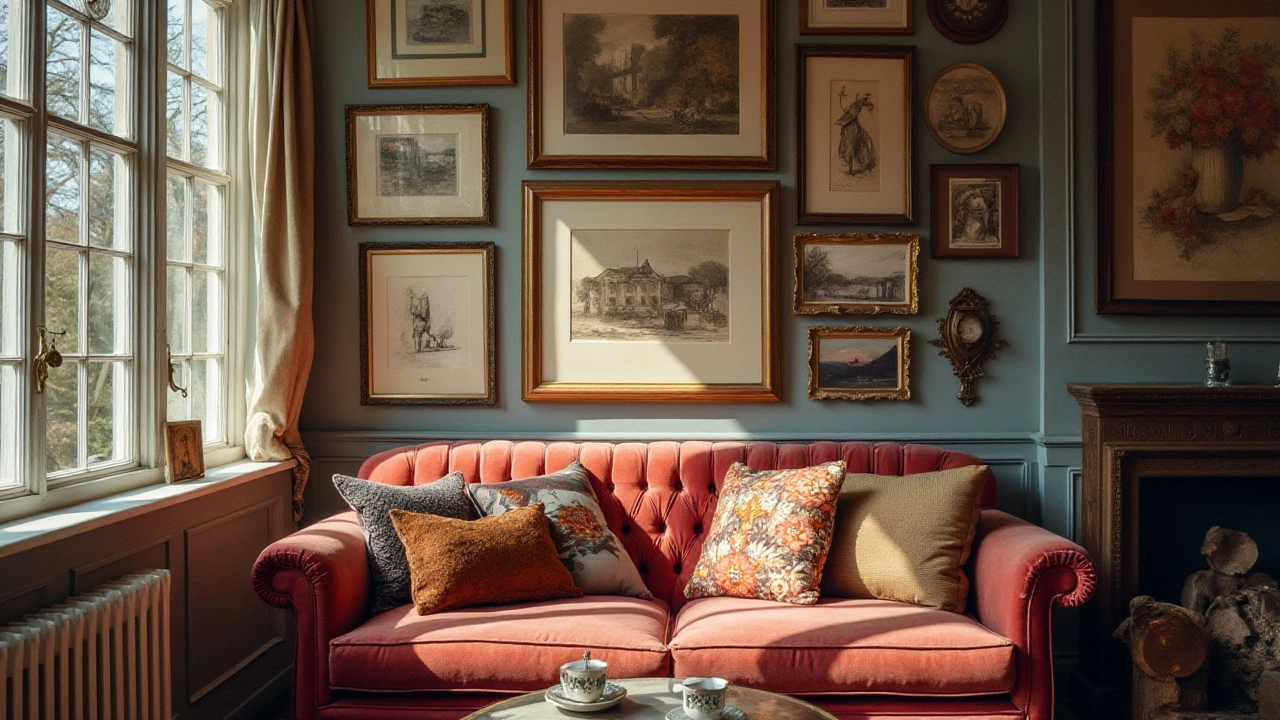
In the ever-evolving world of interior design, elevating your living room to reflect luxury doesn't always come with a hefty price tag. One of the most effective ways to achieve an upscale look is through thoughtful wall art. Art has the potential to transform a space, infusing it with personality, emotion, and richness.
Choosing the right artwork—or even creating your own—is a journey into personal taste and style. It's about selecting pieces that not only resonate with you but also bring coherence to your space. Whether it's a striking canvas painting, an intricately designed tapestry, or minimalist art prints, each choice contributes to the overall aesthetic of your home.
But it’s not just about the artwork itself. How you display it can make all the difference. Strategic placement and thoughtful arrangements can create a focal point, making an ordinary wall extraordinary. Additionally, mixing different styles and textures brings depth and interest, offering a sophisticated and curated feel to your living room.
As a final stroke of magic, incorporating personal touches and unexpected elements lend warmth and authenticity, making your room not just elegant but truly yours. Discover these creative strategies and transform your living room into a hub of luxury and style.
- Choosing the Right Art Pieces
- Placement and Arrangement
- Mixing Styles and Textures
- Incorporating Personal Touches
Choosing the Right Art Pieces
When it comes to selecting luxury wall art for your living room, it is crucial to consider both style and substance. Art has the extraordinary ability to set the mood of a room and can whisper stories of distant lands, historical events, or personal triumphs. But the magic lies in choosing pieces that harmonize with your existing decor and speak to your personal taste. This means contemplating several factors—artistic style, color palette, size, and the emotion it elicits.
Firstly, consider the scale of the artwork in relation to your wall. A small piece on a vast wall can feel insignificant, while an oversized piece might overwhelm. The rule of thumb is that art should occupy about two-thirds to three-fourths of the wall space where it is displayed. This ratio ensures that the piece feels well-proportioned within the room. Additionally, paying attention to the height at which your art is hung is vital; typically, art should be hung at eye level to ensure it is both accessible and impressive.
Color plays an integral role in art selection. While it is tempting to choose art that matches the predominant colors in your room, mixing in complementary hues can create a dynamic and engaging visual experience. Consider invoking a sense of calm with cool blues or stimulating the senses with vibrant reds, always ensuring that the colors enhance rather than clash with your living room decor. It's often beneficial to use a color wheel to find either analogous colors (those close to each other on the wheel) for soothing harmony or complementary colors (opposite on the wheel) for a more striking effect.
Another dimension to consider is the style and subject matter of the art. A piece of art can be a statement of style—contemporary, abstract, classical, or even eclectic. The decision should align with both the theme of your living room and your personal aesthetic. As the renowned artist Marc Chagall once said,
“Great art picks up where nature ends.”Consider choosing pieces that reflect your personal narrative or that of your family, perhaps an abstract piece that evokes a powerful personal memory or a serene landscape that reminds you of your favorite vacation spot.
Finally, never underestimate the power of supporting locally owned galleries or budding artists. Not only does this add an element of uniqueness and personal pride to your collection, but it also supports the art community at large. Purchasing from lesser-known artists can provide an eclectic mix that stands out. Often, these pieces can appreciate over time, lending not only aesthetic but also monetary value to your collection. Always ask the artist or the gallery for backstories of each piece—the narrative can further enhance the emotional and relational aspect of your selections within your home.
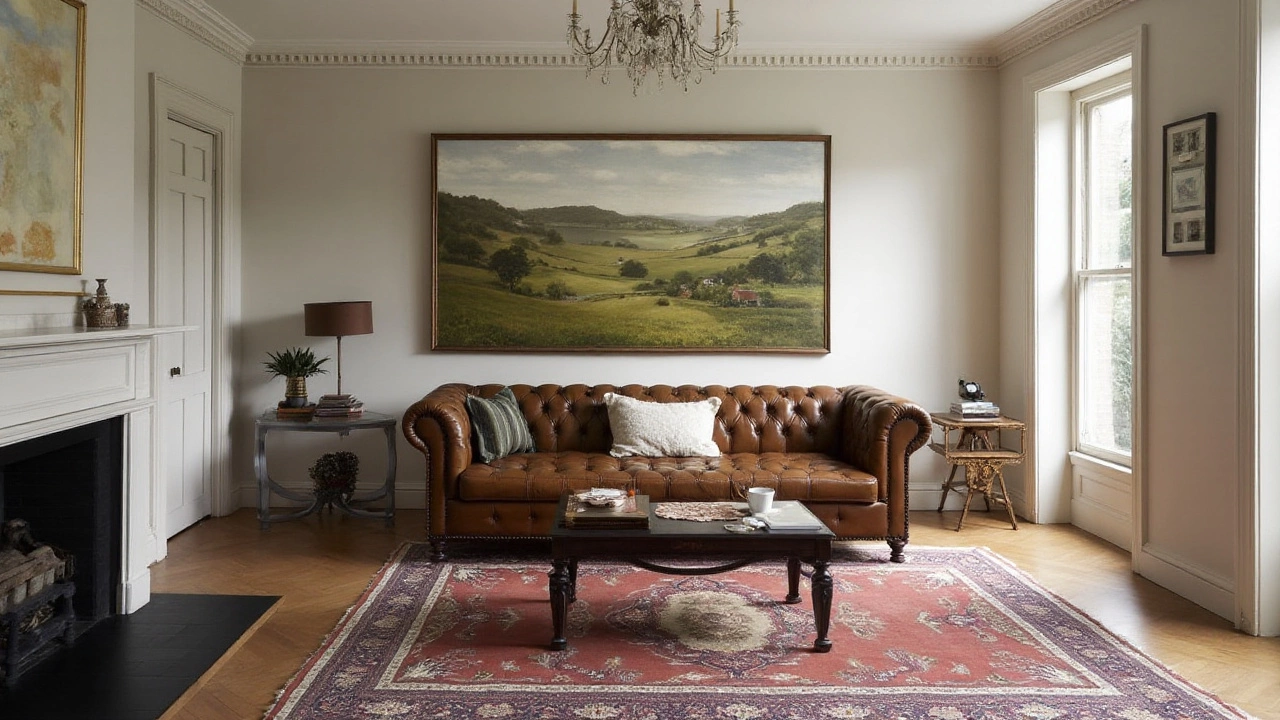
Placement and Arrangement
Mastering the art of living room decor begins with the strategic placement and arrangement of wall art. It’s an art form in itself, one that can instantly enhance the aesthetic appeal of your home. When it comes to transforming your space into a stylish interior reminiscent of luxurious homes, where and how you position your wall art is crucial. The higher you place an art piece, the more it draws the eye upwards, adding an illusion of height to the room. Alternatively, positioning it at eye level encourages interaction and invites conversation.
Consider the size of your wall. Large walls can host oversized pieces or a gallery wall arrangement. A singular large piece can serve as a bold focal point, while a curated collection of smaller pieces can be arranged symmetrically or asymmetrically to provide visual interest and depth. When hanging multiple pieces, spacing is key; aim for a consistent gap that allows each piece to stand out without overwhelming the viewer. With smaller walls, selecting compact art pieces or creating a tiered arrangement can maintain balance without overcrowding.
Lighting plays a significant role in how wall art is perceived; natural light can amplify the colors and textures of your artwork, while softer, ambient lighting can create a cozy and inviting atmosphere. According to renowned designer Nate Berkus, "Pictures should hang so that someone can delight in them whether they are passing by or having a seat." Proper lighting and positioning can transform an ordinary living room into a place of elegance and warmth.
Another effective strategy is to mix and match mediums and styles. Combining traditional paintings with modern art prints, or perhaps photographs with abstract designs, can break the monotony and create a room with layers of personality. For those unsure where to start, creating mock layouts on the floor until you find the harmony your space requires is a wise practice. This planning phase helps visualize the end result, ensuring each piece complements the others and the room as a whole.
| Art Type | Ideal Placement |
|---|---|
| Canvas Paintings | Centered over furniture like sofas or mantles |
| Art Prints | Grouped in a grid for symmetry |
| Photographs | Clustered to tell a visual story |
The key to effective placement and arrangement is to trust your instincts and express your personal style. By playing with scale, light, and juxtaposition, you can transform your living room into a luxurious retreat. Once you understand these principles, you'll be on your way to crafting a space that exudes both sophistication and your own unique flair.
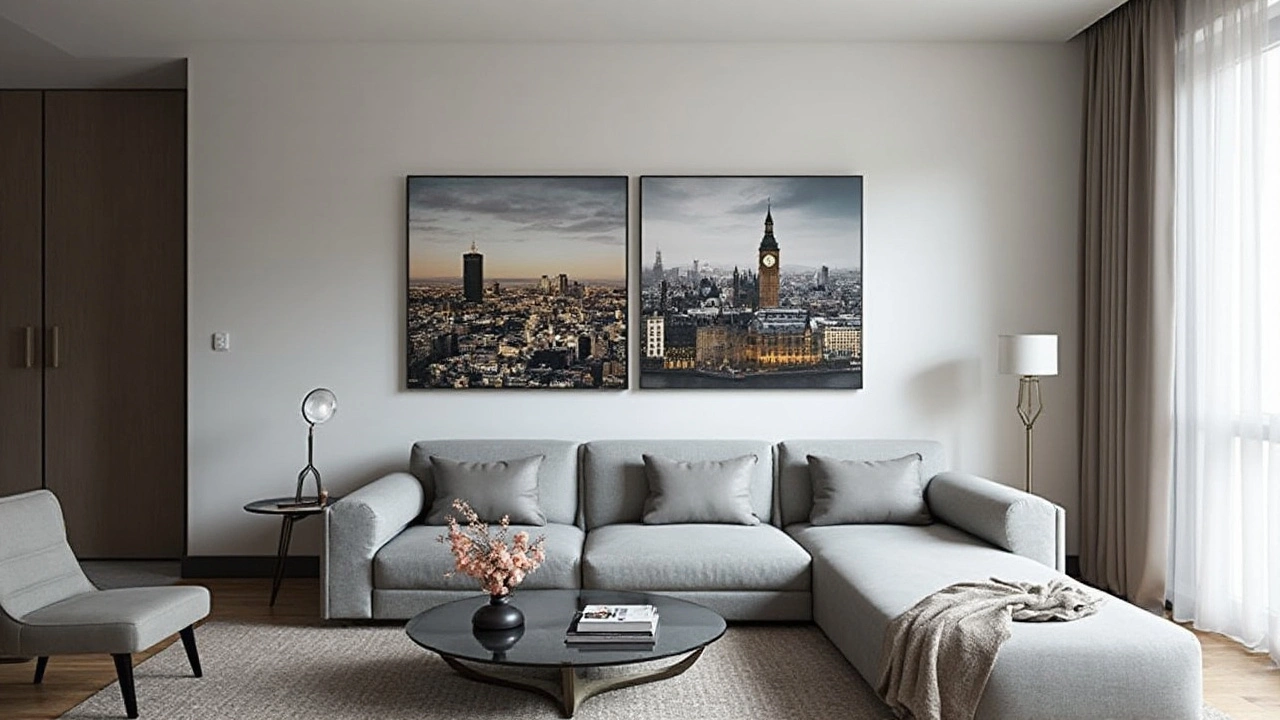
Mixing Styles and Textures
Exploring the art of mixing styles and textures in your living room can bring a depth and sophistication that mirrors a page of a stylish interior magazine. Combining wall art that spans different eras, mediums, and genres creates a compelling visual narrative. One might think that mixing styles can create chaos, but when done with care, it leads to a harmonious blend of boldness and subtlety. Consider the aesthetic of pairing modern minimalist prints with more classical oil paintings; such combinations draw the eye and invite appreciation for the diverse expressions contained within a single room.
Textures play a pivotal role in elevating the overall ambiance. The tactile nature of materials adds layers of interest beyond the visual. Imagine placing a plush velvet wall hanging alongside a sleek metal sculpture, each piece engaging different senses. The juxtaposition of a rustic wood-framed painting next to a glossy acrylic work can balance natural warmth with modern coolness. When selecting pieces, consider how their textures will interact with existing furnishings, helping to integrate the art into your living space seamlessly.
Historical Influence and Modern Trends
Embracing historical and contemporary influences can breathe new life into your living room decor. The inclusion of replicas or genuine antiques can weave storytelling elements into your setting, linking past sophistication with present trends. In the words of design legend Jonathan Adler, "Your home should tell the story of who you are, and be a collection of what you love." This approach encourages a more meaningful engagement with decor, where each piece is chosen for its story as much as its visual impact. Combining a vintage map print with a contemporary abstract painting can highlight the evolution of style, each adding unique value to your art collection.
When mixing styles and textures, don't hesitate to incorporate unexpected and eclectic elements. Whether it’s an edgy piece of street art paired with delicate floral sketches or a chunky knit wall hanging against a sleek, glossy painting, these combinations can make your living room feel both luxurious and lived-in. A strategic approach involves maintaining a coherent color palette or recurring themes that tie disparate items together seamlessly. This doesn't just reflect luxury—it creates a layered personality for your home, ensuring each piece's uniqueness shines through while still complementing the overall design scheme.
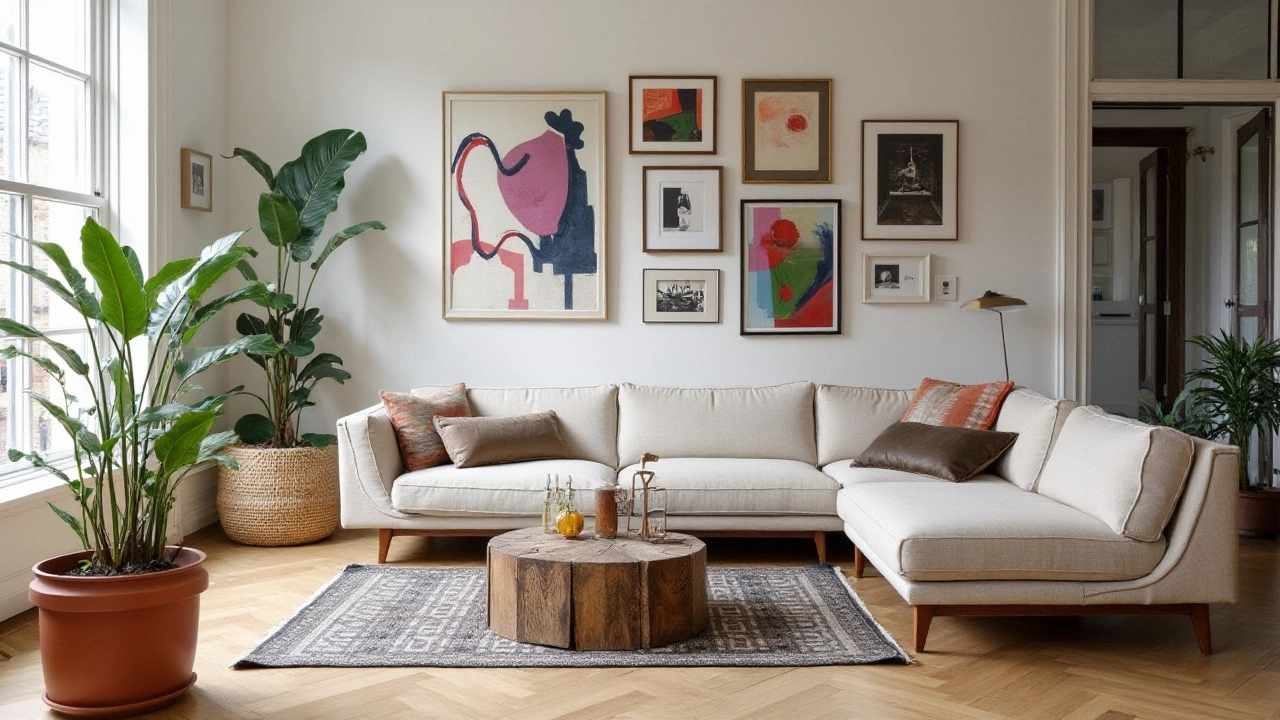
Incorporating Personal Touches
Adding personal touches to your living room decor transcends the mere arrangement of objects; it tells a story, a narrative of who you are and what you cherish. The beauty of luxury wall art lies not only in its visual appeal but in how it connects with your personal sense of style. While generic decorations might offer an aesthetic upgrade, personal touches transform your living space into a warm, inviting sanctuary that dialogues with everyone who steps in. When selecting art, consider pieces that reflect meaningful aspects of your life. Perhaps it's a photograph from a memorable trip, a canvas of an abstract piece that speaks to your soul, or even a collection of small prints that together convey a larger message.
One way to incorporate personal elements is by integrating family photos into your living room decor. Frame these images with elegance, choosing frames that complement the existing theme of your room. If you want to keep things cohesive, try images in black and white or select frames of a uniform color palette. Alternatively, creating a gallery wall filled with diverse personal art can make for a striking visual impact. This approach not only showcases varied memories but adds an intriguing texture to your walls.
Interestingly, a survey from the home design industry noted that 76% of homeowners find that incorporating personal touches into their home decor greatly enhances their emotional well-being. This statistic reveals the profound effect that personalized elements have on our living spaces, turning ordinary rooms into havens of comfort and joy. Moreover, personal touches can take various forms beyond conventional art. Incorporate items like handwritten quotes, pressed flowers, or even small sculptures crafted by loved ones. These accents not only embellish your space but breathe life into the walls they adorn.
"Your home should tell the story of who you are, and be a collection of what you love," says renowned interior designer Nate Berkus. This advice is crucial when pondering how to weave personal narratives into your decor. Try focusing on elements that elicit memories or inspire joy. Art doesn't have to be exclusive or expensive; it just needs to be significant.In experimenting with stylish interiors, consider the use of DIY projects as well. Handmade wall art pieces can add a layer of authenticity and charm to your decor. Whether it's a painting you've made yourself or a framed poem your child wrote, these pieces bring a unique character to any room. Such creations contribute layers of personality and creativity, making your living space genuinely yours.


